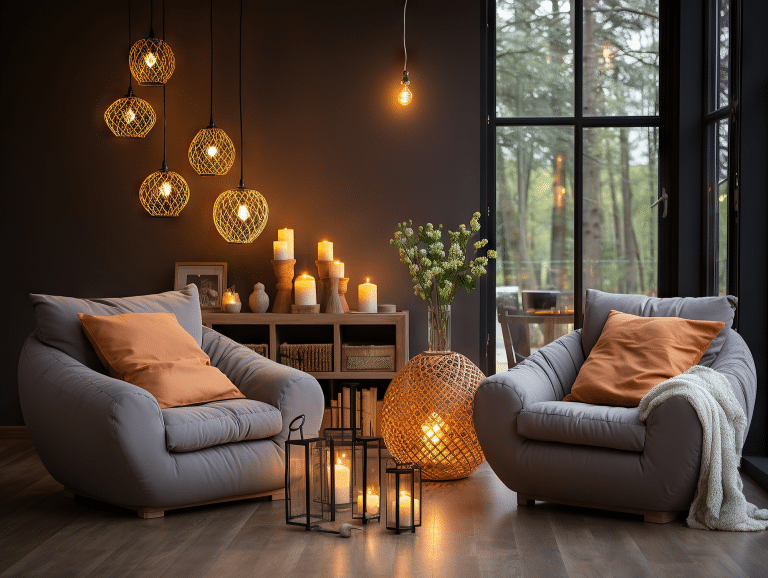Walk into any beautifully designed home, and you’ll notice something special about the atmosphere. While we often credit furniture choices or color schemes for a room’s appeal, the true magic often lies in something less obvious: the lighting. The right illumination has an almost mystical ability to completely reshape how we experience our homes, turning ordinary rooms into extraordinary spaces.
Think about your favorite restaurant or hotel lobby. Chances are, the lighting played a major role in creating that memorable ambiance you loved. The same principles that designers use in commercial spaces can work wonders in your home, and understanding them doesn’t require a degree in interior design.
Setting the Mood Through Light
Lighting directly influences our emotions and energy levels. Bright, cool-toned lights tend to energize us and promote focus, making them perfect for home offices or kitchens where we need to stay alert. Conversely, warm, dimmed lighting helps us unwind after a long day, which is why it works beautifully in bedrooms and living rooms.
The color temperature of your bulbs matters more than you might think. Measured in Kelvins, warmer lights (around 2700K-3000K) cast a yellowish glow that feels cozy and inviting. Cooler lights (4000K and above) produce a bluish-white light that mimics daylight. By choosing the right temperature for each room’s purpose, you create an environment that naturally supports the activities happening there.
Layering Light for Depth and Dimension
One of the biggest mistakes people make is relying on a single overhead fixture to light an entire room. This creates harsh shadows and a flat, uninviting atmosphere. Professional designers use a layering technique that combines three types of lighting: ambient, task, and accent.
Ambient lighting provides overall illumination for a room. This typically comes from ceiling fixtures, recessed lights, or modern light fixtures that distribute light evenly throughout the space. Task lighting focuses on specific areas where you need concentrated light for activities like reading, cooking, or working. Desk lamps, under-cabinet kitchen lights, and vanity lights fall into this category. Accent lighting adds drama and visual interest by highlighting architectural features, artwork, or plants.
When you combine these three layers, something remarkable happens. Your rooms gain depth and character. Different areas can serve different purposes, and the space feels more dynamic and intentional.
Strategic Placement Changes Everything
Where you position your light sources dramatically affects how a room feels. A table lamp in a dark corner can make a small room feel larger by eliminating shadows and drawing the eye around the entire space. Floor lamps placed behind seating areas create inviting pools of light that make conversation areas feel more intimate.
Don’t forget about vertical space. Wall sconces and uplighting can make ceilings appear higher and rooms feel more spacious. This trick works particularly well in rooms with lower ceilings or in narrow hallways that might otherwise feel cramped.
Natural Light as Your Foundation
Before investing in new fixtures, maximize the natural light you already have. Clean windows regularly, choose window treatments that can be fully opened during the day, and position mirrors to bounce sunlight deeper into your rooms. Natural light not only saves energy but also connects us to the rhythm of the day, supporting our natural circadian rhythms.
Once you’ve optimized natural light, select artificial lighting that complements it. During daylight hours, you want your lights to blend seamlessly with the sun. As evening approaches, your lighting can shift to create a different, more relaxed atmosphere.
The Power of Dimmers and Smart Controls
Installing dimmer switches might be the single best lighting investment you can make. Dimmers give you complete control over a room’s mood, allowing the same space to function differently at various times of day. Your dining room can be bright and energetic for weekend brunch, then transform into an intimate dinner setting by evening.
Smart lighting systems take this flexibility even further. You can program different scenes for different activities, adjust lights from your phone, and even sync lighting with your daily schedule. While these systems require more initial investment, they offer unmatched versatility.
Choosing Fixtures That Make a Statement
Your lighting fixtures themselves are sculptural elements that contribute to your room’s style. Modern light fixtures with clean lines and innovative designs can serve as focal points, especially in dining rooms and entryways where overhead fixtures naturally draw attention.
Consider scale carefully when selecting fixtures. A chandelier that’s too small will look lost in a large room, while an oversized pendant can overwhelm a cozy breakfast nook. As a general rule, measure your room’s length and width in feet, add those numbers together, and that sum in inches gives you an appropriate diameter for a central fixture.
Making the Change
Transforming your living space with lighting doesn’t require a complete overhaul overnight. Start with one room and experiment. Add a floor lamp to a dark corner or replace builder-grade fixtures with something more distinctive. As you begin to see the difference proper lighting makes, you’ll develop an eye for opportunities throughout your home.
The beauty of lighting is that it’s one of the most impactful changes you can make without major renovation. With thoughtful planning and strategic choices, you can create a home that not only looks better but genuinely feels better to live in.













